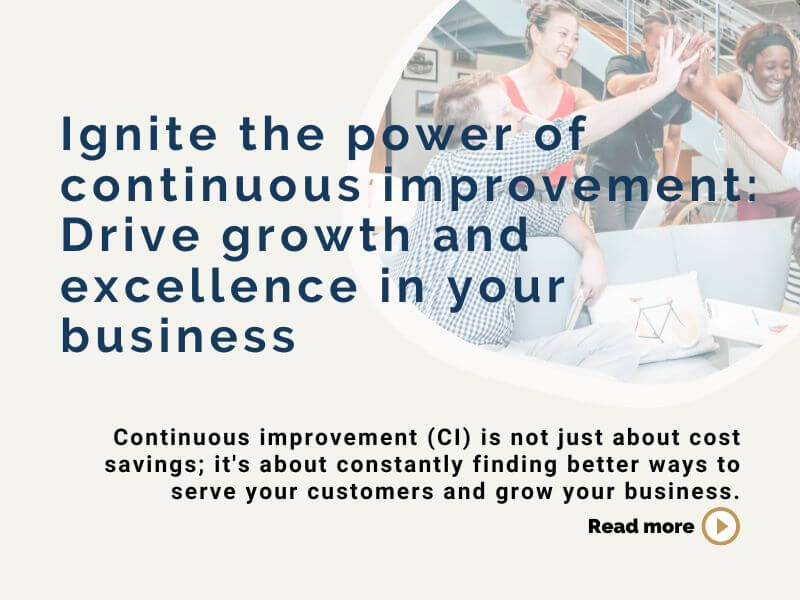In business, continuous improvement (CI) is not just about cost savings; it’s about constantly finding better ways to serve your customers and grow your business.
Embracing CI ensures that we remain humble and adaptable, and always strive for excellence in our businesses.
Arianna Huffington, co-founder of The Huffington Post and CEO of Thrive Global once stated:
“The fastest way to break the cycle of perfectionism and become fearless is to give up the idea of doing it perfectly – indeed to embrace uncertainty and imperfection.”
As a small business owner, we can’t be perfect, we need to embrace continuous improvement as a necessity for survival and growth. I believe businesses that fail to adapt and continuously improve their operations – or be too perfect – will inevitably be left behind in today’s ever-evolving marketplace.
CI is the key to staying relevant and thriving in a competitive business environment, and in this blog, you’ll learn why.
What is Continuous Improvement (CI)?
Continuous improvement in business refers to the ongoing process of identifying and implementing positive changes to enhance efficiency, quality, and productivity. It involves analysing existing practices, seeking feedback, and implementing incremental improvements.
By fostering a culture of continuous improvement, savvy business owners can strive to optimise processes, increase customer satisfaction, and stay competitive in their industry.
Why do small businesses need Continuous Improvement (CI)?
Small businesses need continuous improvement for several reasons. Firstly, CI allows you to identify and rectify inefficiencies in your operations, leading to cost savings and improved profitability.
It also helps you as a small business owner to stay competitive by adapting to changing customer needs and market trends.
If you foster a culture of innovation and learning, empowering employees to contribute ideas and solutions, you will enable your small business to enhance its overall performance and achieve sustainable growth in a highly competitive business landscape.
Sounds great, doesn’t it? But how do you do that, exactly? Well, I’m glad you asked and I invite you to read on.
3 things all business owners need to do before implementing a CI plan
We know ongoing evaluation and optimisation in business will enhance productivity, quality and customer satisfaction – and there are specific steps, which I’ll share with you in this section. But first, there are three things you need to do first.
1. Have a continuous improvement mindset:
Leaders must have the right mindset to seek for improvement. Ongoing continuous improvement leads to long-term productivity and customer satisfaction, and you have to have a mindset that believes and works towards this. Read my blog on mindset here.
2. Standardise processes:
Document your business processes for evaluation and optimisation processes. Well-documented systems, processes and procedures mean you can share knowledge with your team and train them to ensure consistent outcomes across the business.
3. Measure performance:
Set KPIs and metrics to track and measure performance. Setting purposeful metrics helps the business to gain insights into the efficiency and effectiveness of the processes you have documented. This data-driven approach enables the identification of bottlenecks, inefficiencies, and areas with the highest potential for improvement.
Implement the Plan-Do-Check-Act (PDCA) method
In the dynamic landscape of business, knowing the most effective path to take can be a challenge. However, there is a proven method that can provide clarity and drive progress: The PDCA method.
Acknowledging that there is always room for improvement is essential for any business owner or manager (but it’s not always easy).
The PDCA method offers a systematic approach to gain control, enhance productivity, and strengthen continuous improvement within your business processes.
Now is the perfect time to embrace this method, chart a clear course, and get your business on the right path towards sustained success.
- Plan: Begin by carefully analysing your current situation and defining your desired outcomes. Utilise process mapping techniques to visually map out the tasks and decisions required to achieve your goals. By answering fundamental questions about your business objectives, challenges, available resources, and measures of success, you can develop a comprehensive plan that serves as your roadmap.
- Do: With a solid plan in place, it’s time to put it into action. Break down your goals into manageable steps and execute them. By setting short-term milestones and continuously tracking progress, you can maintain a sense of momentum and celebrate ongoing achievements. Flexibility and adaptability are key during this phase, as unforeseen obstacles may arise. Be prepared to make adjustments and ensure everyone involved understands their roles and responsibilities.
- Check: Evaluation and reflection are crucial aspects of the PDCA method. Regularly assess the effectiveness and efficiency of your actions and outcomes. This involves gathering and analysing relevant data, measuring performance against predetermined metrics, and identifying areas for improvement. Actively seek feedback from stakeholders and engage in constructive discussions to generate new ideas and solutions.
- Act: Based on your evaluation, take decisive action to make necessary improvements and optimise your processes. Implement changes that have been proven effective and adjust your approach accordingly. Continuously monitor and measure the results to ensure that your actions align with your desired outcomes.
The PDCA method is an ongoing cycle that encourages a culture of continuous improvement. It helps to create an environment where learning, innovation, and adaptation are valued.
By embracing this method, you will empower yourself and your team to consistently strive for excellence, drive positive change, and achieve sustainable growth.
Remember, success is not a destination but a continuous journey. The PDCA method provides the framework to navigate this journey, allowing you to confidently steer your business towards ongoing improvement and long-term success.
Utilise PDCA for various business scenarios
The PDCA (Plan-Do-Check-Act) cycle can be harnessed in multiple business scenarios, including initiating improvement projects, developing designs, defining work processes, analysing data, implementing changes, and working towards continuous improvement.
Learn more: If you’re interested to know more about the PDCA method, check out this online article here.
Get a PDCA procedure in place
To implement the PDCA procedure effectively, businesses must follow a four-step approach:
- Identifying opportunities and planning changes
- Testing changes through small-scale examples
- Evaluating results and learning from them
- Taking action based on the findings
And it’s crucial to involve the team in this procedure and exercise to build a collaborative and innovative environment within your small business.
By leveraging the PDCA method and involving the entire team, small business owners with big visions can navigate the journey of continuous improvement, which in turn will help you achieve long-term success.
Is it time to get expert help?
Are you feeling overwhelmed and uncertain about your business?
That stress and worry could be because of your need to optimise your current business systems, processes and procedures because right now all of that amazing information is in your head and your team can’t help you effectively.
If you’ve already started reviewing your processes and know you need assistance in completing them, I’ve got you covered.
Let me help you get unstuck and unlock your business’s huge growth potential by eliminating stress from your business life.
Let’s have a chat, figure out what you need help with and ensure a successful outcome. Simply contact me here.






